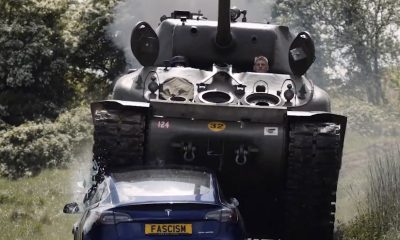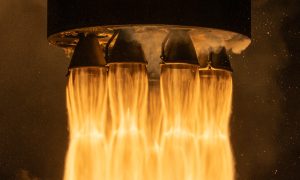

News
Sierra Space’s Dream Chaser space plane to be moved to Florida ahead of launch
Sierra Space recently completed testing of Dream Chaser ‘Tenacity’ at NASA’s Neil Armstrong Test Facility in Sandusky, Ohio.
The space plane will be launched atop United Launch Alliance’s Vulcan rocket and will carry cargo to the International Space Station, finished an intense amount of testing that included facing extreme temperatures and shock testing.
In preparation for the rigors of space, Dream Chaser underwent sine vibration testing at @NASAglenn‘s Armstrong Test Facility. While each test only lasts about 90 seconds, the data ensures the vehicle can perform within @ulalaunch‘s launch parameters.https://t.co/5wR6S3ZKD6 pic.twitter.com/X2Du7NmiBP
— Sierra Space (@SierraSpaceCo) February 27, 2024
Dream Chaser was put through many tests to ensure it could survive the trip to space and a lengthy stay in orbit at the Space Station.
The first test saw the space plane, along with its additional cargo attachment ‘Shooting Star’, connected to the Vulcan Centaur stage separation mechanism for a shock test, followed by being placed on the most powerful spacecraft shaker table in the world. This testing took place over 5 weeks as teams replicated the conditions the space plane would see during launch on Vulcan. They also conducted the same testing but replicated the separation of the cargo attachment from Dream Chaser before de-orbiting.
After that round of testing, the space plane was moved into a thermal vacuum chamber which can cycle temperatures from -150F to +250F (-101C to +121C), the same temperatures it would see while in space.
Tenacity and its cargo module are currently undergoing thermal vacuum testing at NASA’s Armstrong Test Facility in Ohio. These tests are a crucial step in its journey towards the launchpad and for our mission to redefine the future of space commercialization. pic.twitter.com/czIh75GWoz
— Sierra Space (@SierraSpaceCo) April 3, 2024
With this testing complete, Sierra Space will transport Dream Chaser Tenacity to NASA’s Kennedy Space Center for its last round of testing before being attached to ULA’s Vulcan rocket. Sierra Space and ULA are hoping to launch in 2024 if final testing flows smoothly and the Vulcan rocket is ready.
Sierra Space is also currently working on its next Dream Chaser, Reverence, which will also be used to transport cargo to the ISS.
Questions or comments? Shoot me an email at [email protected], or Tweet me @RDAnglePhoto.
News
Tesla China registrations bounce back to 11.1k vehicles in May’s 2nd full week
Tesla China’s domestic vehicle registrations have been volatile in recent weeks.

Tesla reported 11,130 insurance registrations in China in the week of May 12-18, 2025. These represent a 262.5% increase from 3,070 registrations that the company saw in the week ending May 11.
Tesla China’s domestic vehicle registrations have been volatile in recent weeks, suggesting that Giga Shanghai may still be exporting Model 3 and Model Y vehicles to foreign territories this month.
Tesla China’s Registrations
In the week ending May 4, Tesla China saw 7,300 new vehicle registrations. This was not that surprising considering that Tesla may still be allocating Gigafactory Shanghai’s output to vehicle exports. In the week ending May 11, however, industry watchers were quite surprised to see just 3,070 registrations from Tesla China.
The 262.54% bounce in vehicle registrations in the week ending May 18 is thus a pleasant update from the world’s biggest and most competitive electric vehicle market. Even with these results, however, industry watchers still note that Tesla China’s registrations this 2025 are still down 6.5% year-over-year.
Tesla China does not report its weekly sales figures, though the company’s overall performance in the domestic automotive sector can be inferred through new vehicle registration data. Fortunately, these registrations are closely tracked by industry watchers, as well as local automakers such as Li Auto.
Domestic Sales and Exports
Following the start of domestic deliveries of the new Model Y in China, expectations were high that the company would see a steady rise in registrations this second quarter. Giga Shanghai does not only supply vehicles to the domestic Chinese market, after all, as the facility also serves as the company’s primary vehicle export hub, providing Model 3 sedans and Model Y crossovers to several territories.
Tesla China sold 28,731 vehicles domestically and exported 29,728 vehicles in April. In comparison, the company saw 74,127 domestic registrations and 4,701 exports in March 2025, as per data compiled by CNEV Post. Considering Tesla China’s registrations this May, it would not be surprising if the company’s exports this month would exceed March’s 4,701 units.
News
xAI receives more Tesla Megapacks for Colossus 2

xAI is bolstering its Colossus 2 data center in Memphis with 168 Tesla Megapacks, enhancing the energy infrastructure for its ambitious AI supercomputer expansion. The deployment underscores xAI’s push to lead AI innovation while addressing environmental concerns.
The first Colossus site is connected to a 150 megawatts (MW) substation powered by MLGW and TVA. It is supported by approximately 156 Megapacks, providing 150 MW of stored energy backup to xAI’s supercomputer. The 168 Tesla Megapacks recently delivered to xAI’s Memphis site will provide battery storage backup to Colossus 2.
In December 2024, xAI doubled the capacity of Colossus to 200,000 Nvidia H100 GPUs, which consumes 250 MW of power–enough to energize 250,000 homes. In March 2025, the AI company bought a 1-million-square-foot site in Whitehaven, Memphis, for $80 million. xAI’s Whitehaven site could host up to 350,000 GPUs with the potential to deploy the largest number of Tesla Megapacks for backup power.
xAI plans to scale Colossus up to 1 million GPUs to create the world’s largest AI supercomputer. A 1-million-GPU setup would require over 1 gigawatt, about one-third of Memphis’s peak summer demand.
Initially reliant on natural gas turbines, Colossus faced criticism for nitrogen oxide emissions. The 150 MW substation, completed in early 2025, reduced turbine use by half, with Megapacks providing cleaner backup power. By fall 2025, xAI expects the second substation to come online. Once the second substation is online, the remaining turbines will only be used for backup, reducing the project’s carbon footprint.
Tesla Energy’s Q1 2025 performance, with a 156% year-over-year increase and 10.4 GWh of storage deployed, supports xAI’s needs. Tesla’s Megapack factory in Waller County, Texas, set to create 1,500 jobs, signals further commitment to scaling energy solutions for projects like Colossus.
xAI’s rapid expansion, backed by Tesla Megapacks, positions it to rival AI leaders like OpenAI and Google. The Colossus 2 deployment reflects a strategic blend of cutting-edge AI and sustainable energy. As Memphis’ infrastructure adapts to unprecedented power demands, xAI and Tesla are reshaping the AI landscape with a focus on efficiency and environmental responsibility.
News
Grok 3 by xAI Rolls Out on Azure AI Foundry with Free Trial
Grok 3 is now on Azure AI Foundry with a free preview until early June. From code to vision, Grok joins a growing roster of powerhouse models.

xAI’s Grok 3 model is now available on Microsoft’s Azure AI Foundry Models, launching with a free preview to drive AI innovation. The collaboration marks a significant step in making advanced AI accessible to developers worldwide.
Grok 3 became available on Microsoft’s Azure AI Foundry Models on May 19, 2025. Developers can explore xAI’s Grok 3 at no cost through early June. After the free trial period, Grok 3 prices will be as follows:

“Microsoft and xAI are thrilled to unveil the availability of Grok 3 into the Azure AI Foundry Models, marking a significant milestone in AI accessibility and innovation,” Microsoft stated in its announcement.
The partnership integrates xAI’s cutting-edge model with Azure’s secure, scalable infrastructure, enabling enterprise scenarios in reasoning, coding, and visual processing. Grok 3 is accessible via Azure AI Foundry’s catalog, alongside models from OpenAI, Meta, Cohere, NVIDIA, and Hugging Face, reflecting Microsoft’s commitment to a diverse AI ecosystem.
“The addition of xAI’s Grok 3 underscores Microsoft’s commitment to support an open, diverse AI ecosystem, rather than relying on a single model provider,” the company noted.
Like other AI models in Azure, developers can easily discover and deploy Grok 3’s model card. Grok 3 is also available for testing on GitHub models.
Microsoft provides two flexible deployment options for integrating xAI’s Grok 3 into applications: Standard Pay-Go or Provisioned Throughput Units (PTUs). The Standard Pay-Go option allows pay-per-token API calls for quick scaling. Meanwhile, the PTUs are better for reserved capacity with predictable latency.
“For production scenarios where you expect steady high volume or need strict latency, provisioning Grok 3 with PTUs can be cost-effective and reliable,” Microsoft advised.
The launch of Grok 3 on Azure AI Foundry empowers developers to build intelligent assistants, process large documents, or explore new AI applications. As xAI and Microsoft combine innovation with robust tools, Grok 3’s arrival signals a new era of AI development, inviting creators to leverage its capabilities and shape the future of technology.
-

 News2 weeks ago
News2 weeks agoTesla Cybertruck Range Extender gets canceled
-

 Elon Musk5 days ago
Elon Musk5 days agoTesla seems to have fixed one of Full Self-Driving’s most annoying features
-

 Lifestyle2 weeks ago
Lifestyle2 weeks agoAnti-Elon Musk group crushes Tesla Model 3 with Sherman tank–with unexpected results
-

 News2 weeks ago
News2 weeks agoStarlink to launch on United Airlines planes by May 15
-

 News2 weeks ago
News2 weeks agoTesla Semi gets new adoptee in latest sighting
-

 News2 weeks ago
News2 weeks agoTesla launches its most inexpensive trim of new Model Y
-

 News2 weeks ago
News2 weeks agoNew Tesla Model Y proves very sturdy after shocking high-speed crash
-

 News2 weeks ago
News2 weeks agoUS’ base Tesla Model Y has an edge vs Shanghai and Berlin’s entry-level Model Ys






















